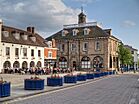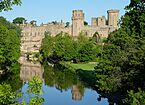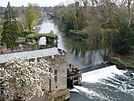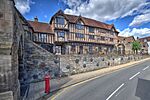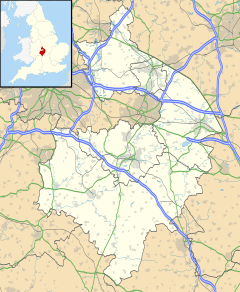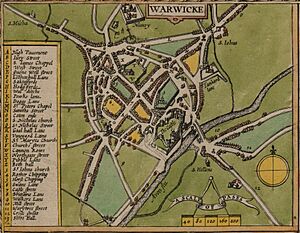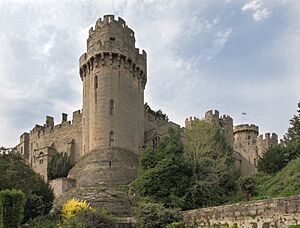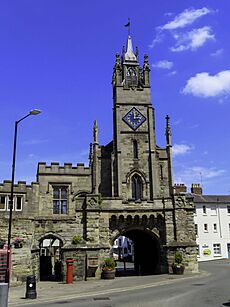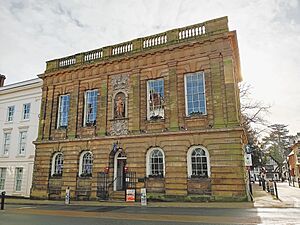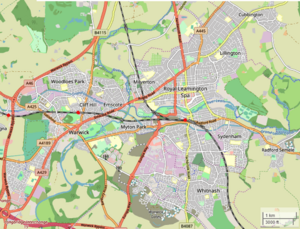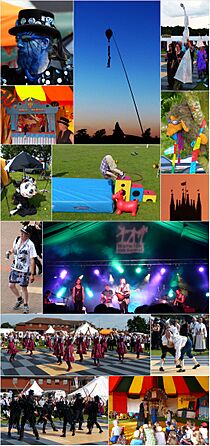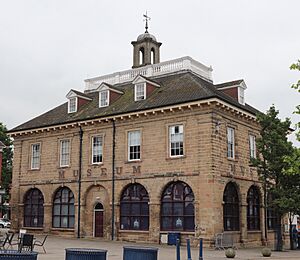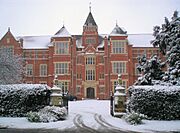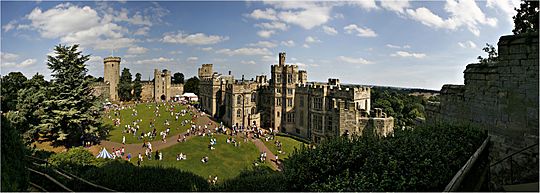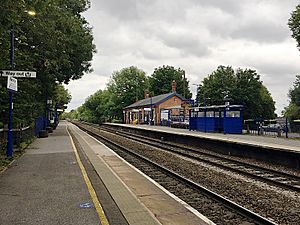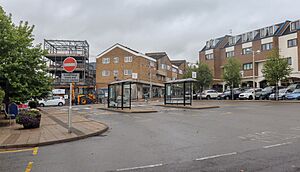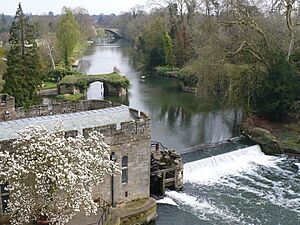Warwick facts for kids
Quick facts for kids Warwick |
|
|---|---|
| Town | |
|
Clockwise, from top: view over Warwick including the Collegiate Church of St Mary; Warwick Castle; Lord Leycester Hospital; the River Avon; Market Square
|
|
| Population | 37,267 (2021 Census) |
| Demonym |
|
| OS grid reference | SP2865 |
| • London | 82 mi (132 km) SE |
| Civil parish |
|
| District |
|
| Shire county | |
| Region | |
| Country | England |
| Sovereign state | United Kingdom |
| Post town | WARWICK |
| Postcode district | CV34, CV35 |
| Dialling code | 01926 |
| Police | Warwickshire |
| Fire | Warwickshire |
| Ambulance | West Midlands |
| EU Parliament | West Midlands |
| UK Parliament |
|
Warwick (pronounced WORR-ik) is a historic town in England. It's the main town of Warwickshire county. You can find it right next to the River Avon. Warwick is about 9 miles (14 km) south of Coventry and 19 miles (31 km) south-east of Birmingham. It's also very close to the towns of Leamington Spa and Whitnash.
Warwick has a very long history, with many old buildings from the Medieval, Stuart, and Georgian times. It was an important fortified settlement long ago. The most famous old building is Warwick Castle, which is a huge tourist attraction today. A big fire in 1694 destroyed much of the town. After the fire, Warwick was rebuilt with beautiful 18th-century buildings. These include the Collegiate Church of St Mary and the Shire Hall. In 2021, about 37,267 people lived in Warwick.
Contents
- Warwick's Past: A Journey Through Time
- How Warwick is Governed
- Warwick's Location and Surroundings
- Who Lives in Warwick?
- Warwick's Economy and Businesses
- Culture and Fun in Warwick
- Hospitals in Warwick
- Sports in Warwick
- Education in Warwick
- Famous Places and Buildings in Warwick
- Getting Around Warwick
- Famous People from Warwick
- Warwick's Twin Towns
- See also
Warwick's Past: A Journey Through Time
Warwick has been a place where people lived for thousands of years.
Early Settlers: Stone Age and Roman Times
People first settled on Warwick's hilltop during the Neolithic period, also known as the New Stone Age. This was between 4000 and 2351 BC. Archaeologists have found over 30 shallow pits with ancient tools and pottery. They also found small holes that show rectangular buildings once stood there. An arrowhead from the Bell Beaker culture, dating from 2500 to 1700 BC, was also discovered.
Later, during the Roman period, a large Roman barn was found at the site of Warwick School. This barn was built in the 2nd century AD. Roman rule in Britain began to weaken around 367–408 AD, and Roman soldiers eventually left.
Saxon Warwick: A Fortified Town
Warwick continued to be lived in from the 5th century onwards. The town's old English name, Wæringwīc, might mean a 'settlement with lots of trade' or a 'fortification'. It could also refer to a 'weir' (a small dam) over the River Avon.
In 914, a powerful Anglo-Saxon leader named Æthelflæd built a 'burh' (a fortified town) in Warwick. She was the daughter of King Alfred the Great. She built these forts to protect Mercia from the Vikings. Warwick was a good spot for a fort because it had a defensible hilltop near the river, with good water and building materials.
Warwick became the main town for its area, called a 'shire', in the early 10th century. A royal mint, where coins were made, was set up in Warwick around 924-939 AD. This mint made coins until the mid-12th century. In 1016, the Danes attacked Mercia and burned down much of Warwick, including a nunnery.
Norman and Medieval Warwick: Castle and Walls
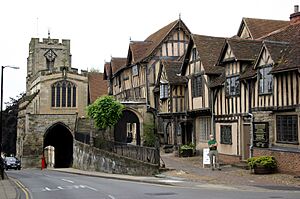
William the Conqueror built Warwick Castle in 1068. He was on his way to deal with a rebellion in the north of England. Building the castle meant tearing down four houses. The castle was inside the older Anglo-Saxon fort. A new town wall was built around Warwick.
Medieval Warwick grew because it was an important administrative and military center. However, it wasn't a big trading or industrial hub. The town was controlled by different Earls of Warwick, especially the Beauchamp family. Warwick became a walled town. We don't know exactly when the walls were built, but they were mentioned in the 12th century. Most of the walls were gone by the early 1500s.
Today, only the east and west gatehouses remain. The West Gate was first mentioned in 1129. It had a chapel above it, which was rebuilt in the 14th century. The East Gate was rebuilt in the 15th century and again in 1788. It was once part of The King's High School for Girls and is now a holiday home.
Many medieval buildings in Warwick were destroyed over time. However, the Lord Leycester Hospital on High Street is a great example of an old building, with parts dating back to 1383. Warwick officially became a 'borough' (a town with its own government) in 1545.
17th Century: Civil War and the Great Fire
During the English Civil War, Warwick town and castle supported Parliament. In 1642, the Royalists tried to attack the castle, but they didn't have strong enough cannons. The attack failed when the Royalists had to leave. A group of 302 soldiers guarded the castle until 1659.
The Great Fire of Warwick

On September 5, 1694, a huge fire destroyed much of Warwick's medieval town center. In just five hours, 460 buildings were burned, and 250 families lost their homes. Because of this, most buildings in the town center today are from the late 17th and early 18th centuries. Some older timber-framed buildings still stand, especially on the edges of the town center.
After the fire, Warwick was rebuilt in the popular Georgian style. Architects like Francis Smith and the Hiorne brothers designed many of the new buildings. Daniel Defoe, a famous writer, said that Warwick was rebuilt so beautifully that "few towns in England make so fine an appearance."
The fire also burned down much of the medieval church of St Mary. However, the chancel (the area around the altar) and the Beauchamp Chapel survived. The Beauchamp Chapel was built between 1443 and 1464. It contains a beautiful copper-gilt statue of Richard Beauchamp, Earl of Warwick, who died in 1439.
From the 18th Century to Today
In 1788, a new bridge, Castle Bridge, was built over the Avon. It opened in 1793 and replaced an older bridge. Canals were opened through Warwick in 1800, which are now part of the Grand Union Canal.
The railway arrived in Warwick in 1852, connecting the town to Birmingham, Oxford, and London. However, express trains often stopped at nearby Leamington Spa railway station instead. Warwick was not heavily affected by the Industrial Revolution. Only small industries like hat making developed here. By the early 20th century, some engineering businesses were established.
The Warwick Pageant was a big festival held at Warwick Castle in 1906. A tram service ran between Warwick and Leamington Spa from 1881 to 1930. In 2021, Warwick tried to become a city as part of the Queen's Platinum Jubilee, but it was not chosen.
How Warwick's Population Has Grown
Historians believe Warwick had about 1,500 people in 1086. By the mid-1500s, it was around 2,000, growing to over 3,000 by the late 1600s. The first national census in 1801 counted 5,592 people. This number almost doubled to 10,952 by 1851. Growth was slower for the next century, reaching 16,051 in 1961. Since then, the population has almost doubled again, reaching 31,315 in 2011.
How Warwick is Governed
Warwick has three levels of local government:
- Warwick Town Council: This council manages local town matters. It is based at the Court House on Jury Street.
- Warwick District Council: This council covers a wider area. Even though it's named after Warwick, its main office is in Leamington Spa.
- Warwickshire County Council: This council handles county-wide services. Its headquarters are at Shire Hall in Warwick.
Warwick has grown so much that it now joins up with its bigger neighbor, Leamington Spa, and also Whitnash. Together, these towns form a larger urban area with about 95,000 people.
Warwick is part of the Warwick and Leamington constituency in the UK Parliament. This area has been represented by a Labour Party Member of Parliament (MP) since 2017. Before that, it was often represented by a Conservative MP.
Warwick's Location and Surroundings
An old writer named William Dugdale described Warwick as "standing upon a rocky ascent... and in a dry and fertile soil." He also mentioned "rich and pleasant meadows on the south part... and... woodland on the north."
Two main things have shaped Warwick's buildings and layout: the Great Fire of 1694 and the fact that it didn't become a big industrial city. In the 19th century, while many English towns became industrial, Warwick largely stayed the same. This was partly because it wasn't on major trade routes, and the River Avon wasn't navigable all the way to Warwick.
Warwick's Neighborhoods
Warwick has several neighborhoods, or suburbs. These include Bridge End, Cliff Hill, Emscote, Woodloes Park, Forbes, Myton (which connects Warwick to Leamington Spa), Packmores, The Cape, The Percy, Warwick Gates, Chase Meadow, and Myton Green.
Warwick Gates is a newer housing area and business park built in the late 1990s. It's in Heathcote, south-east Warwick. Even though it's separated from the town center by fields, it's part of Warwick's local area. It's next to Whitnash and the village of Bishops Tachbrook. The NHS Leamington Spa Hospital is also near Warwick Gates.
Chase Meadow is another new area built to the south-west of the town, near Warwick Racecourse. It has a pub and places to eat. More recently, Myton Green was built south of Myton.
Warwick's Weather
Warwick has a typical English climate. This means it has a small range of temperatures, with mild winters and cool summers. The nearest official weather station is at Wellesbourne, about 6 miles (10 km) south of Warwick.
The hottest temperature ever recorded was 36.1°C (97.0°F) in August 1990. On a typical warm day, the temperature might reach 30.0°C (86.0°F). The coldest temperature ever recorded was -17.8°C (0.0°F) in January 1982. On average, there are about 53 days a year when the temperature drops below freezing. Warwick gets about 608 mm (24 inches) of rain each year.
| Climate data for Wellesbourne, elevation 47 m (154 ft), 1971–2000, extremes 1960– | |||||||||||||
|---|---|---|---|---|---|---|---|---|---|---|---|---|---|
| Month | Jan | Feb | Mar | Apr | May | Jun | Jul | Aug | Sep | Oct | Nov | Dec | Year |
| Record high °C (°F) | 14.5 (58.1) |
17.8 (64.0) |
21.7 (71.1) |
26.3 (79.3) |
28.1 (82.6) |
32.8 (91.0) |
35.4 (95.7) |
36.1 (97.0) |
28.9 (84.0) |
23.9 (75.0) |
18.8 (65.8) |
15.6 (60.1) |
36.1 (97.0) |
| Mean daily maximum °C (°F) | 7.0 (44.6) |
7.5 (45.5) |
10.2 (50.4) |
12.8 (55.0) |
16.5 (61.7) |
19.4 (66.9) |
22.4 (72.3) |
21.9 (71.4) |
18.4 (65.1) |
14.1 (57.4) |
9.8 (49.6) |
7.7 (45.9) |
14.0 (57.2) |
| Mean daily minimum °C (°F) | 0.9 (33.6) |
0.8 (33.4) |
2.4 (36.3) |
3.6 (38.5) |
6.2 (43.2) |
9.1 (48.4) |
11.3 (52.3) |
11.2 (52.2) |
9.3 (48.7) |
6.5 (43.7) |
3.2 (37.8) |
1.7 (35.1) |
5.5 (41.9) |
| Record low °C (°F) | −17.8 (0.0) |
−14.5 (5.9) |
−10 (14) |
−6.6 (20.1) |
−2.8 (27.0) |
−1.7 (28.9) |
2.2 (36.0) |
1.7 (35.1) |
−2.2 (28.0) |
−5.7 (21.7) |
−8.5 (16.7) |
−17.4 (0.7) |
−17.8 (0.0) |
| Average precipitation mm (inches) | 53.84 (2.12) |
39.86 (1.57) |
45.27 (1.78) |
44.86 (1.77) |
49.3 (1.94) |
53.57 (2.11) |
44.75 (1.76) |
56.32 (2.22) |
57.58 (2.27) |
54.97 (2.16) |
50.18 (1.98) |
57.77 (2.27) |
608.46 (23.96) |
| Source: KNMI | |||||||||||||
Who Lives in Warwick?
In 2011, Warwick had 31,345 residents living in 14,226 homes. The average age of people in Warwick was 39.
Most residents (88.1%) were White British. About 7.9% were Asian, 0.7% were Black, and 2.2% were of mixed ethnicity.
When it comes to religion, 58.0% of people in Warwick said they were Christian. About 26.9% said they had no religion. Other religions included Sikh (4.6%), Hindu (1.3%), Muslim (1.0%), and Buddhist (0.4%).
Warwick's Economy and Businesses
Warwick is a good place for businesses because it's close to major motorways that connect north-south and east-west across England. Many companies have their main offices here.
For example, National Grid UK, a big energy company, has its UK headquarters at Warwick Technology Park. Phillips 66 and their petrol station brand, JET, also have an office there. Other companies with offices in Warwick include the lingerie company Bravissimo, IBM, Wolseley, and Volvo Group UK. These are located on the Wedgnock Industrial Estate. Bridgestone, Calor, Kantar, and Delphi Automotive also have regional offices in Warwick.
There's also a shopping park outside the town called Leamington Shopping Park.
Culture and Fun in Warwick
Warwick hosts several fun festivals every year. These include:
- A spoken word festival (for poetry and storytelling)
- Classical and contemporary music festivals
- A folk festival
- A Victorian Evening, usually held in late November or early December.
St. Mary's Church holds concerts featuring early music. The Bridge House Theatre hosts "Music-in-Round" concerts. The Warwick Chamber of Trade helps promote the town for visitors and businesses.
Warwick is most famous for Warwick Castle, which started being built in 1068. The town center is also known for its mix of Tudor and 17th-century buildings.
The town also has Warwick Racecourse, where horse racing events are held. There's even a small golf course inside the racecourse.
J. R. R. Tolkien, the author of The Lord of the Rings, was married in Warwick at the Catholic Church of Saint Mary Immaculate. Some experts believe that Warwick and its history, especially its connections to the ancient kingdom of Mercia, influenced places in his books like Edoras and Minas Tirith.
Warwick's historic buildings have been used in many TV shows and movies. These include the BBC drama Dangerfield, period dramas like Pride and Prejudice, and parts of Doctor Who. Filming for A Christmas Carol also took place here in 2019.
Museums to Explore
The Warwickshire Museum has two locations in Warwick:
- Market Hall: This historic 17th-century building in the Market Square has collections focused on archaeology, geology, and natural history, especially things found locally in Warwickshire.
- St John's House: This 17th-century house shows what a Victorian kitchen and classroom looked like. It also houses the museum for the Royal Warwickshire Regiment of Fusiliers.
Local Media
Local news and TV shows for Warwick come from BBC West Midlands and ITV Central.
Warwick has several local radio stations: BBC CWR (103.7 FM), Capital Mid-Counties (107.3 FM), Hits Radio Coventry & Warwickshire (102.9 FM), and Fresh (Coventry & Warwickshire) (a DAB station).
Local newspapers include the Warwickshire Telegraph and The Boar, which is a student newspaper for the University of Warwick.
Hospitals in Warwick
Warwick has a few hospitals:
- Warwick Hospital
- Leamington Spa Hospital
- St Michael's Hospital (a psychiatric unit).
Sports in Warwick
Warwick Racecourse is just west of the town center. Next to it is Racing Club Warwick F.C., a football club founded in 1919. Warwick also has other long-standing sports clubs, like Warwick Hockey Club, which started in 1920.
Education in Warwick
Schools in Warwick
Warwick has several secondary schools:
- Warwick School: An independent school for boys, offering day and boarding options.
- The King's High School For Girls: Also an independent school.
- Myton School and Aylesford School: State-run schools that teach both boys and girls.
- Campion School and Trinity Catholic School in Leamington Spa also serve parts of Warwick.
Warwick Preparatory School is an independent day school and nursery for younger children. It's part of the Warwick Independent Schools Foundation, along with King's High School and Warwick School.
Warwick School: A Very Old School
Warwick School is an independent school for boys that claims to be the oldest boys' school in England. No one knows its exact founding date, but some say it was as early as 914. The school claims King Edward the Confessor (who lived around 1004–1066) gave it a special charter. However, there's no clear proof of this. King Henry VIII re-founded it in 1545. What we do know is that there has been a grammar school in Warwick since before the Norman Conquest. The school moved to its current location south of the River Avon in 1879.
University of Warwick: Not Quite in Warwick
The closest university is the University of Warwick. It's named after the county of Warwickshire, not the town itself. In fact, it's located several miles north of Warwick, on the edge of Coventry. This can be a bit confusing because Coventry is no longer in Warwickshire county; it's in the West Midlands. So, the university actually sits across both counties!
Famous Places and Buildings in Warwick
Warwick is full of interesting landmarks and buildings:
- Collegiate Church of St Mary
- Gurdwara Sahib Leamington and Warwick
- Guy's Cliffe House
- Lord Leycester Hospital
- Lord Leycester Hotel
- Market Hall
- Market Square
- The Dream Factory
- St John's Museum
- St Michael's Leper Hospital
- St. Nicholas' Park
- Saxon Mill
- Shire Hall
- Warwick Castle
- Warwick Hospital
- Warwick Racecourse
- Warwick School
- Hill Close Gardens
- St Mary Immaculate Roman Catholic Church
Getting Around Warwick
By Road
Warwick is located on the M40 motorway, which connects London and Birmingham. It's also on the A46 dual-carriageway, a main road between Coventry and Stratford-upon-Avon. Warwick has several car parks, both public and private (like those at the railway station and the castle).
By Train
The town has two train stations, both on the Chiltern Main Line:
- Warwick railway station: This station is close to the town center. You can catch direct trains to Leamington Spa, London, Birmingham, and Stratford-upon-Avon. These services are run by Chiltern Railways.
- Warwick Parkway: This station opened in 2000 and is on the western edge of town. It offers frequent trains to London and Birmingham.
From 1881 to 1930, a tram service also ran between Warwick and Leamington Spa.
By Bus and Coach
Bus services to Leamington Spa, Stratford-upon-Avon, and Coventry are operated by Stagecoach in Warwickshire from the bus station in the town center. There's also a National Express coach stop at the bus station for longer journeys. Warwick Parkway train station also has a coach stop with more frequent services.
By Waterways
The Grand Union Canal passes through Warwick. The Saltisford Canal Arm is a restored part of the canal near the town center. It's a short branch of the original Warwick and Birmingham Canal, built in 1799. Today, it's a place where colorful narrowboats are moored, and it has a waterside park open to the public.
The River Avon also flows through Warwick, but you can't travel by boat on it all the way to Warwick. The part of the river you can navigate ends at Stratford-upon-Avon. There have been ideas to extend the river navigation to Warwick, which would involve building new locks. However, the most recent plans were not supported by the local council in 2019.
By Air
The closest international airport to Warwick is Birmingham Airport. It's about 20 miles (32 km) away by road. There used to be a Royal Air Force base called RAF Warwick.
Famous People from Warwick
Many interesting people have come from Warwick.
Warwick's Twin Towns
Warwick has special "twinning" agreements with two towns in Europe:
- Saumur, France (since 1976)
- Verden, Germany (since 1989)
There's also a friendship link between Warwick District and Bo District in Sierra Leone.
See also
 In Spanish: Warwick para niños
In Spanish: Warwick para niños



